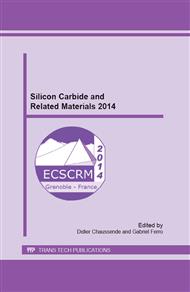p.165
p.169
p.173
p.177
p.181
p.185
p.189
p.193
p.197
Low Pressure Homoepitaxial Growth of 4H-SiC on 4°off-Axis Substrates
Abstract:
Step-bunching and triangular defects are significant problems in achieving higher growth rate 4H-SiC epilayers in a horizontal hot wall CVD reactor using a standard non-chlorinated chemistry of silane-propane-hydrogen on 4°off-axis substrates. In this work, the impact of growth pressure on generation of step-bunching and triangular defects and the correlations between the surface roughness and the formation of defects were investigated. It has been found that the impact of growth pressure on concentration of the triangle defects and surface roughness is obviously different. An overall reduction of defects was observed with decreasing growth pressure while the surface roughness increased. The increased adatom surface mobility in low pressure range and minimization of surface free energy are the main reasons for the phenomenon above. High Resolution X-Ray Diffraction (HRXRD) indicated that the structural quality of 4H-SiC epilayers performed at low pressure was higher than that obtained at high pressure.
Info:
Periodical:
Pages:
181-184
Citation:
Online since:
June 2015
Authors:
Keywords:
Price:
Сopyright:
© 2015 Trans Tech Publications Ltd. All Rights Reserved
Share:
Citation:


